Sphinginae subfamily
Sphingini tribe:
 |
Pink "ribs" on abdomen and on hindwings are diagnostic, but occasionally a variation "decolora"
whithout the pink has been observed.
|
 |
Ceratomia amyntor
WO,
the Elm Sphinx or Four-horned Sphinx:
The upperside of the forewing is brown with dark brown and white markings including a white costal area near the wing base, dark streaks along
the veins, and a white spot in the cell. The upperside of the hindwing is light brown and has a dark brown band along the outer margin.
Larvae feed on Elm (Ulmus), birch (Betula), basswood (Tilia), and cherry (Prunus).
|
 |
The upperside of the forewing is yellowish brown with no white markings, but there are indistinct black lines and dashes. The cell spot is gray with a
black outline and the upperside of the hindwing is yellowish brown with obscure lines. The larvae feed in large groups and are much more
spectacular than the moths. Catalpa is the larval host.
|
 |
Ceratomia undulosa
WO,
the Waved Sphinx: The upperside of the forewing is pale brownish gray with wavy black and white lines and a black-outlined white cell spot.
The upperside of the hindwing is gray with diffuse darker bands.
Some individuals are very dark, almost black, and others are light yellowish brown.
|
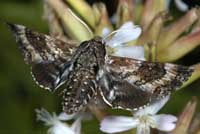 |
The upperside of the forewing is dark brown with a dusting of white scales. Some moths have patches of reddish or yellowish brown on the wings.
Larvae are not limited to pawpaw.
|
 | The upperside of the forewing is gray with heavy black bands. The upperside of the hindwing is brownish gray with no markings.
The underside is rather plain
|
 |
Lapara coniferarum
WO, Southern Pine Sphinx:
Fw upperside gray with two (sometimes one or three) black dashes near wing center; other markings usually diffuse.
Hw upperside uniform brown-gray.
This species does not have more sharply contrasting black markings of fresh L. bombycoides. Extensive reddish brown patch in
median area near fw inner margin.
|
 |
Lintneria eremitus
WO, the Hermit Sphinx:
The upperside of the forewing is gray-brown with wavy lines, black dashes, and one or two small white spots near the center of the costa.
The upperside of the hindwing is black with two white bands and a triangular black patch at the base. Note the golden hair on the thorax
|
 |
Manduca jasminearum
WO the Ash Sphinx:
The upperside of forewing is gray to grayish brown with a black line running from the middle of the costa to the middle of the outer margin; the line
may be broken near the margin. There is a splash of brown around the cell spot. The upperside of the hindwing is mostly black, with gray at the lower margin.
|
 |
Manduca quinquemaculatus
WO the Five-spotted Hawkmoth:
Abdomen usually has five but sometimes six pairs of yellow bands. Fw upperside blurry brown and gray.
Hw upperside banded with brown and white and has two well-separated median zigzag bands. Fw fringes
grayish, not distinctly spotted with white.
|
 |
Manduca sexta
WO, the Carolina Sphinx:
Abdomen usually has six pairs of yellow bands, broken across the back. Sixth pair quite small.
Fw upperside: indistinct black, brown, white markings.
Hw upperside: banded with black, white; two black zigzag median lines very close together with hardly any white showing between them.
Fw fringes spotted with white.
|
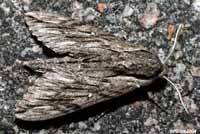 |
Paratrea plebeja
WO, the Plebian Sphinx:
The upperside of the forewing is gray with indistinct black and white markings. There is a series of black dashes from the base to the tip,
and a small white cell spot. The upperside of the hindwing is dark gray with an obscure dark median band.
|

|
Sphinx canadensis
WO,
Sphinx canadensis, the Canadian Sphinx, is not common, and is not
often reported anywhere.
Fw upperside gray-brown or yellow-gray with black streaks along and between veins and an
interrupted white line along outer margin. Hw upperside black with white bands.
Larval hosts are white ash (Fraxinus americana) and blueberry
(Vaccinium).
|
 |
Sphinx chersis
WO, the Northern Ash Sphinx or Great Ash Sphinx
The upperside of the forewing is soft dark gray to blue-gray with a series of black dashes,
one of which reaches the wing tip. The upperside of the hindwing is black with blurry pale gray bands.
Larval hosts are ash, lilac, privet, cherry, and quaking aspen.
|
 |
Sphinx drupiferarum
WO, the Wild Cherry
Sphinx: The forewing is dull slate grey with considerable light grey scaling in a broad band along the costa about 3/4 of distance from body toward the apex. Median
lines are black and thin. There is a wavy, diffuse dark subterminal line, inwardly bordered by white, and a whitish bar in terminal area, paralleling outer margin.
|
 |
Sphinx gordius
WO, the Apple Sphinx: Fw fringes: mostly black with some
white; Hw fringes: mostly white with a few black patches.
Fw upperside ranges from brown with black borders through brownish gray with paler borders to pale gray with no borders.
Dashes, submarginal line, and cell spot are usually weak.
|
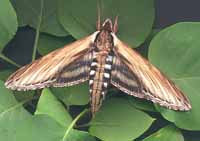 |
The lower forewings are predominantly brownish-yellow with a fairly wide dark bar along the
inner margin. At rest the wings hug the body, giving the moth a long slender look.
|
 |
Sphinx luscitiosa
WO,
the Canadian Sphinx or
Clemen's Sphinx:
Upperside of fw is yellowish gray in males and pale
gray with faint yellow tint in females. Dark
border on outer margin widens as it approaches inner margin.
Upperside of hw is deep yellow in males,
pale yellow in females; both with wide black border.
|
 |
Sphinx poecila
WO, the Poecila Sphinx: Fw fringes: checkered black and white; Hw fringes almost pure white (lightly checked with grey).
Fw dark gray with diffuse black and gray wavy lines with series of black dashes ending at wing tip, and white cell spot. Cell spot
readily distinguishes poecila from canadensis. Hw brownish gray with wide black border and black median line.
|
Smerinthini Tribe:
 |
The adults are also highly variable; sometimes wings of an individual may be all one color or may have several colors, ranging
from pale to dark brown, and may have a white or pink tinge. Patterns range from faint to pronounced.
See the file for the female; she is different. |
 |
Pachysphinx modesta
WO, the Modest Sphinx or Poplar Sphinx
This moth has a large, heavy body, and females can be remarkably plump. |
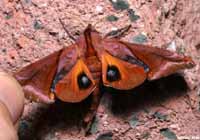 |
Both sexes rest with wings parallel to the resting surface, with the upper lobes of the hindwings protruding above the forewings. The lower abdomen of the male arcs
upward toward the head, while the abdomen of the female hangs strait down on a vertical surface.
|
 |
Paonias excaecata
WO,
the Blinded Sphinx: Fw outer margin is quite wavy. There is a dark cell spot and a dark oblique line mid wing from costa almost to inner margin.
Basic ground colour is pinkish brown.
At rest the lower wings are almost completely hidden.
Males demonstrate a strong curve to abdomen.
Moth gets its name from blue-gray pupil surrounded by black, with hot pink wing scales in hw basal area.
|
 |
Named for the small eye-spot in the hindwing, this moth has a wide
distribution.
I regularly see them on Prince Edward Island, and they are reported
as far south as Florida.
|
 |
Smerinthus jamaicensis
WO, the Twin-spotted Sphinx:
Similar to but smaller than S. cerisyi. Larger blue patches on more vibrant, deeper purple in
lower wings. Note complete (i.e. outer margin to outer margin) off-white arc just below fw apex.
In S. cerisyi, lower portion of arc does not return to outer margin. |
Macroglossinae subfamily
Dilophonotini tribe:
See Hemaris comparison to help distinguish
the next three species.
 |
Hemaris thysbe
WO, the Hummingbird Clearwing
It is not difficult to see why many gardeners would mistake an
Hemaris thysbe moth for a small hummingbird as it hovers,
sipping nectar from flowers through a long feeding tube. Off-white legs.
|
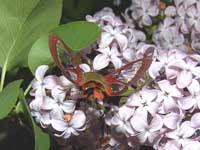 |
Hemaris gracilis
WO,
Slender Clearwing or Graceful Clearwing:
Gracilis is distinguished from similar species by pair of red-brown
bands on sides of thorax, varying from green to yellow-green
dorsally and sometimes brown with white below. Abdomen is red. Wings
are transparent with reddish brown borders. Red legs.
|
Philampelini tribe:
 |
The forewing is light grey and brown with many lines, and there are dark patches near
the middle of the inner margin, near the apex and near the anal angle. The entire basal area of the hindwing is pink.
|
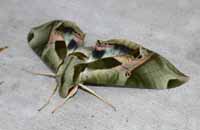 |
Eumorpha pandorus
WO, the Pandorus Sphinx:
Fw upperside is light brown with prominent shades of olive green to green. Fw has pink streaks along vein ends and near inner margin, and dark squarish mark
at middle of inner margin.Area from base to squarish mark is dark green.
Underside usually yellow-green, but sometimes pale brown.
|
Macroglossini tribe:
 |
If you have Virginia Creeper, you
probably have the Nessus Sphinx. Two bright, distinct, narrow
yellow bands are often visible on the abdomen.
|
 |
The upperside of the forewing is pale silvery gray with black
markings. The upperside
of the hindwing is deep yellow-orange with a black border that
covers less than half the wing. rare; unlikely possibility
|
 |
The lower wings of this hawkmoth are a solid brownish-orange,
matching the body colour.
You will often see this species listed as Darapsa pholus,
especially in older literature.
|
 |
Darapsa myron WO, the Virginia Creeper Sphinx or the Grapevine Sphinx
FW upperside is dark brown to pale yellowish gray, with an olive tint
(often quite green).
On the costal margin there is a dark rectangular patch, although this
may be reduced or absent. HW upperside is pale orange.
|
 |
If you have hydrangea growing near a stream, then you may have the
Hydrangea Sphinx. It has not been widely reported, however, and
probably is uncommon.
|
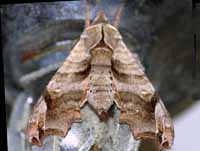 |
The moth's outer margin of the forewing is deeply scalloped.
The upperside is light brown with dark brown markings.
There is a small black and white spot near the tip.
The upperside of the hindwing is orange-brown with a dark brown outer
margin and median line.
|
 |
Hyles gallii WO , the Bedstraw Hawk Moth
or Gallium Sphinx
Note thick, irregular, creamy transverse line on forewings and the
absence of thin white lines on forewings and thorax.
|
 |
Hyles lineata WO , the White-lined Sphinx
The forewing upperside is dark olive brown with paler brown along the
costa and outer margin, a narrow tan band running from the wing tip
to the base, and white streaks along the veins.
The hindwing upperside is black with a reddish pink median band.
|
 |
Adults are said to mimic bumblebees and make a buzzing sound when
feeding. The wing margins are scalloped. The upperside of the
forewing is dark brown with light brown bands and markings. The
upperside of the hindwing is yellow with a wide black outer margin.
|
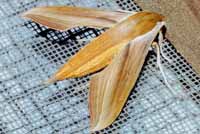 |
The upperside of the forewing is pale brown with lavender-gray at the base and has dark brown lengthwise lines
throughout. The upperside of the hindwing is dark brown with a band of whitish, wedge-shaped marks.
|
|
|
